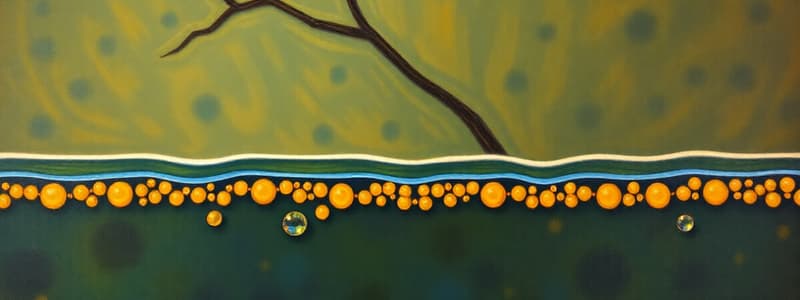Podcast
Questions and Answers
What is the primary driving force behind simple diffusion across a membrane?
What is the primary driving force behind simple diffusion across a membrane?
- Concentration gradient (correct)
- Carrier proteins
- Energy from ATP hydrolysis
- Electrical gradient
Which factor does NOT influence the diffusion rate of particles across a membrane?
Which factor does NOT influence the diffusion rate of particles across a membrane?
- Electric potential across the membrane
- Concentration gradient
- Time of exposure (correct)
- Size of the diffusing particles
What is the primary mechanism of substances moving from a region of lower concentration to a region of higher concentration?
What is the primary mechanism of substances moving from a region of lower concentration to a region of higher concentration?
- Facilitated diffusion
- Simple diffusion
- Passive transport
- Primary active transport (correct)
How is hydrophobicity measured for a substance?
How is hydrophobicity measured for a substance?
Which type of transport protein remains always open and is often referred to as a 'leaky' channel?
Which type of transport protein remains always open and is often referred to as a 'leaky' channel?
What characterizes substances that move easily through the lipid bilayer?
What characterizes substances that move easily through the lipid bilayer?
Which type of transport does NOT require energy expenditure?
Which type of transport does NOT require energy expenditure?
In secondary active transport, the movement of a target substance is coupled with what type of ion movement?
In secondary active transport, the movement of a target substance is coupled with what type of ion movement?
Which term describes the process in which substances move from an area of higher concentration to an area of lower concentration without the use of energy?
Which term describes the process in which substances move from an area of higher concentration to an area of lower concentration without the use of energy?
Which of the following transport proteins are specifically characterized as ATPases?
Which of the following transport proteins are specifically characterized as ATPases?
How does the Na+/glucose symporter function in the context of rehydration therapy?
How does the Na+/glucose symporter function in the context of rehydration therapy?
What is the main role of proton pump inhibitors in the stomach?
What is the main role of proton pump inhibitors in the stomach?
Which action describes the mechanism of ouabain in muscle cells?
Which action describes the mechanism of ouabain in muscle cells?
What is Gatorade primarily designed to do in terms of hydration?
What is Gatorade primarily designed to do in terms of hydration?
In what way can intense dehydration be treated according to the described methods?
In what way can intense dehydration be treated according to the described methods?
When the Na+/K+ pump is inhibited by ouabain, what happens to cytosolic Ca2+ levels?
When the Na+/K+ pump is inhibited by ouabain, what happens to cytosolic Ca2+ levels?
What effect does the acid produced by parietal cells in the stomach have initially?
What effect does the acid produced by parietal cells in the stomach have initially?
How does the Na+/Ca2+ antiporter function in normal conditions?
How does the Na+/Ca2+ antiporter function in normal conditions?
Which ion is most crucial in maintaining the membrane resting potential?
Which ion is most crucial in maintaining the membrane resting potential?
What effect does the Na+/H+ antiporter have when cytosolic pH is decreased?
What effect does the Na+/H+ antiporter have when cytosolic pH is decreased?
What generates the inside-negative membrane potential across the plasma membrane?
What generates the inside-negative membrane potential across the plasma membrane?
Which cotransporter is correctly matched with its function?
Which cotransporter is correctly matched with its function?
What initiates the generation of sodium and potassium concentration gradients in the basolateral surface membrane?
What initiates the generation of sodium and potassium concentration gradients in the basolateral surface membrane?
What is a significant characteristic of uniport transport compared to simple diffusion?
What is a significant characteristic of uniport transport compared to simple diffusion?
How many glucose uniporters (GLUT) are encoded in humans?
How many glucose uniporters (GLUT) are encoded in humans?
What is osmotic pressure?
What is osmotic pressure?
What role do aquaporins play in cell membranes?
What role do aquaporins play in cell membranes?
Which of the following best describes V-class pumps?
Which of the following best describes V-class pumps?
What do ABC superfamily pumps primarily transport?
What do ABC superfamily pumps primarily transport?
Which statement regarding gated channels is true?
Which statement regarding gated channels is true?
What is a characteristic behavior of GLUT transporters?
What is a characteristic behavior of GLUT transporters?
Flashcards are hidden until you start studying
Study Notes
Membrane Transport
- The Na+ concentration gradient and membrane potential are used to drive the uptake of glucose from the intestinal lumen by the 2 Na+/1 glucose symporter located on the apical surface membrane
- The Na+/glucose symporter is the principle behind the ingredients of Gatorade
- Proton pump inhibitors completely shut down the production of stomach acid by inhibiting the hydrogen-potassium adenosine triphosphate enzyme system
- Endogenous ouabain is found in mammals and acts as a steroid hormone
- Ouabain blocks the Na+/K+ pump of muscle which consequentially causes cytosolic Na+ levels to increase and the Na+/Ca2+ antiporter to function less efficiently, causing cytosolic Ca2+ levels to increase.
Biomembranes are Selectively Permeable
- The lipid bilayer structure results in selective permeability meaning only specific substances can move through
Mechanisms of Transmembrane Transport
- Simple Diffusion: The movement of permeable substances across a membrane from a higher concentration to a lower concentration. No energy is expended.
- Facilitated Diffusion: The movement of substances from a higher concentration to a lower concentration with the use of channel proteins or uniport transporters
- Primary Active Transport: The movement of a substance from a lower concentration to a higher concentration with an expenditure of energy. Requires use of proteins called pumps, which are ATPases.
- Secondary Active Transport (Cotransport): Energetically unfavorable transport of a target substance against its concentration gradient is coupled to the energetically favorable movement of an ion down its electrochemical gradient. This can be symport or antiport cotransport.
Simple Diffusion
- Diffusion occurs spontaneously because entropy increases as a substance moves from high concentration to low concentration.
What Determines Diffusion Rate Across a Membrane?
- Concentration gradient across the membrane
- Size of the diffusing particles
- Electric potential across the membrane
- Hydrophobicity (for charged particles)
Hydrophobicity
- Hydrophobicity is measured by the partition coefficient (K), which is the equilibrium constant for a substance's partition between oil and water.
- The higher the K, the more lipid-soluble the substance and the faster its rate of movement across a bilayer.
Transport Protein mediated Processes
- Facilitated Diffusion: Substance moves from a higher concentration to a lower concentration with no expenditure of energy. Usually involves channel proteins or uniport transporters.
- Primary Active Transport: Substance moves from a lower concentration to a higher concentration with the expenditure of energy. Usually involves pumps, which are ATPases.
- Secondary Active Transport: Energetically unfavorable transport of a target substance against its concentration gradient is coupled to the energetically favorable movement of an ion down its electrochemical gradient.
Membrane Transport Proteins
- ATP Powered Pumps: Use energy from ATP to pump substances against their concentration gradient
- Ion Channels: Transport ions, water, and small hydrophilic molecules. May be gated which are closed until opened by a stimulus, or non-gated which are always open.
- Transporters: Bind to specific solutes and undergo conformational changes to move them across membranes
Glucose Uniport Transporters (GLUT)
- Humans have 12 glucose uniporters (GLUT 1-12), which vary in their tissue specificity.
Osmotic Pressure
- Osmotic pressure is the hydrostatic pressure required to stop the net flow of water across a membrane separating solutions of different water concentrations.
Aquaporins
- Aquaporins increase the water permeability of cell membranes.
4 Classes of ATP Powered Pumps
- P-type pumps: phosphorylated during the transport cycle
- V-type pumps: pump protons into organelles.
- F-type pumps: synthesize ATP using proton gradients
- ABC Superfamily pumps: Use ATP to transport a wide range of molecules.
ABC Superfamily
- About 50 pumps in mammals that transport lipids, sugars, and other molecules.
- Examples include MDR1 which transports lipid-soluble substances out of cells and CFTR which transports Cl-.
Flippase Mechanism
- Used by superfamily pumps that transport lipid-soluble substances
Gated and Ungated Channels
- Gated Channels are closed until opened by a stimulus which can be chemical(ligand) or voltage.
- Non-gated Channels are always open, also known as "leaky" channels. Important for maintaining membrane resting potential.
Cotransport
- Examples include: Na+/H+ antiporter, Cl-/HCO3- antiporter, 2Na+/glucose symporter, and 3Na+/Ca+2 antiporter.
Transport Across Epithelial Membranes: Transcellular Glucose Transport from Small Intestine Lumen
- The Na+/K+ ATPase on the basolateral surface membrane generates Na+ and K+ concentration gradients
- The outward movement of K+ ions through nongated K+ channels generates an inside-negative membrane potential across the plasma membrane.
Studying That Suits You
Use AI to generate personalized quizzes and flashcards to suit your learning preferences.




